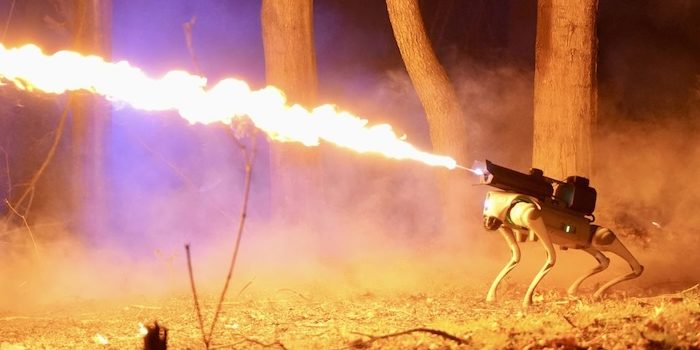(Ken Silva, Headline USA) It’s a robot, it’s a dog. It’s a robot dog—with a flamethrower attached.
And now, it can be yours for $9,420.
The Ohio-based company Throwflame recently unveiled what it’s calling the “Thermonator,” which is touted as the first-ever flame-throwing robot dog.
“This quadruped is coupled with the ARC Flamethrower to deliver on-demand fire anywhere!” Throwflame states on its website.
According to the website, the Thermonator is about 30 inches long and weighs 37 pounds. It can shoot blast streams of fire up to 30 feet.
Throwflame said flamethrowers are unregulated federally, but advised potential buyers to check their state regulations before making a purchase.
Throwflame brags of being the oldest flamethrower manufacturer in the US, and claims to have released the first-ever full-sized, commercially available flamethrower in 2015. That flamethrower, the X15 Flamethrower, sends a stream of flaming fuel or napalm up to 50 feet, according to the company.
Throwflame markets its products to both private individuals and government agencies. Its unveiling of a flame-throwing robot dog comes as police and military departments are looking to increasingly rely on drones and AI.
Such robots could be coming sooner than expected.
Indeed, the Army is reportedly seeking $33 for its 2025 budget to fund “human-machine integrated formations,” or H-MIF, which are essentially robots designed to do the work of humans.
The Military Times has also reported that the Army’s MCOE Experimental Company, 1st Battalion, 29th Infantry Regiment, 316th recently conducted an urban assault with robots.
“Instead of human soldiers rushing across open areas and bursting into buildings, robots took the lead … 20 soldiers with four robotic vehicles were able to cross the open terrain to reach the building. But first robots with smoke generators created a screen,” the publication reported.
“At the same time, robot vehicles with tethered drones jammed enemy signals and extended the soldiers’ network. Small drones dropped robotic ground vehicles with cameras atop buildings to scout the interior while even smaller aerial drones entered windows, scanning the inside of the structure and transmitting back a “blueprint” of the building to soldiers on the ground,” the publication added.
“Then robot “dogs” with cameras of their own, entered the building looking for hazards and seeking out enemy troops.”

